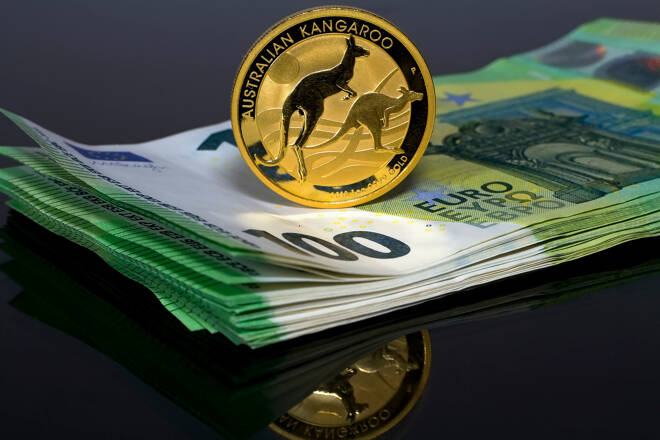Advertisement
Advertisement
AUD to USD Weekly Forecast: Aussie Wages, US Inflation, and Fed Chair Powell
By:
Key Points:
- Australian wage growth figures for Q1 will warrant investor attention after the RBA poured cold water on speculation about a rate hike.
- Unemployment figures from Australia will also influence the RBA interest rate trajectory.
- From the US, the CPI Report, retail sales, and Fed Chair Powell need consideration.
In this article:
Weekly Overview of the AUD/USD in the Week Ending May 10, 2024
In the week ending on May 10, the AUD/USD declined by 0.12% to $0.65996. The AUD/USD rose to a Tuesday high of $0.66437 before falling to a Wednesday low of $0.65579.
AUD/USD Analysis:
On Monday (May 13), Australian business confidence will be in focus. Economists forecast the NAB Business Confidence Index to increase from +1 to +2 points in April.
An upward trend in business confidence would signal an improving economic environment, which could increase hiring and wage growth. Higher wages would increase disposable income, fueling consumer spending and demand-driven inflation.
However, investors should consider the sub-components, including labor cost growth and business conditions – employment.
On Wednesday (May 15), Australian wages will attract investor attention. Upward trends in wage growth could influence the RBA interest rate trajectory. Economists forecast the Wage Price Index to increase 4.2% year-on-year in Q1 after rising 4.2% in Q4 2023.
The Australian labor market will also be in focus on Thursday (May 16). While Q1 wage growth figures will draw the interest of the RBA, weaker labor market conditions in April could impact more.
Weaker-than-expected employment change figures could signal a deterioration in labor market conditions. The net effect would be softer wage growth, which could reduce disposable income and consumer spending. A pullback in consumer spending would dampen demand-driven inflation and raise investor bets on an RBA rate cut.
Economists forecast Australian employment to increase by 25.3k in April after falling by 6.6k in March. Furthermore, economists expect the Australian unemployment rate to increase from 3.8% to 3.9% in April.
Investors should also monitor RBA chatter, with the Aussie labor market under the spotlight. RBA Chief Economist Sarah Hunter is on the calendar to speak on Thursday. Views on household spending, the labor market, and inflation may influence investor sentiment toward the RBA rate path.
US Economic Calendar: Inflation, Retail Sales, and Fed Chair Powell
On Monday, US consumer inflation expectation numbers warrant investor attention. Economists forecast consumer inflation expectations to increase from 3.0% to 3.1% in April. Upward trends in consumer inflation expectations could impact investor bets on a September Fed rate cut.
US producer prices will capture investor attention on Tuesday. Producers increase prices in a higher-demand environment, passing costs onto consumers. As a leading indicator of consumer price inflation, hotter-than-expected numbers will influence the Fed interest rate trajectory.
Economists predict producer prices to increase 2.2% year-on-year in April after advancing 2.1% in March.
On Wednesday, the US CPI report and retail sales figures could impact the US dollar more.
Economists forecast the core annual inflation rate to ease from 3.8% to 3.7% in April.
Higher-than-expected numbers may sink investor bets on a September rate cut and raise expectations of a Fed rate hike. A more hawkish Fed rate path would raise borrowing costs and reduce disposable income. Downward trends in disposable income could force consumers to curb spending, dampening demand-driven inflation.
Moreover, economists predict retail sales to rise by 0.4% in April after increasing by 0.7% in March. Better-than-expected numbers would likely draw the attention of the Fed. An upward trend in consumer spending fuels demand-driven inflation, supporting a more hawkish Fed rate path.
While inflation and consumer spending are the focal points, the US labor market also needs consideration. Initial jobless claims will garner investor interest on Thursday after the recent spike in claims. Economists forecast initial jobless claims to fall from 231k to 220k in the week ending May 11. Weaker labor market conditions could affect wage growth and consumer spending.
The US Federal Reserve and Forward Guidance
Beyond the numbers, Fed Chair Powell is on the calendar to speak on Tuesday. FOMC members Loretta Mester (Mon/Thurs), Philip Jefferson (Mon), Lisa Cook (Tues), Neel Kashkari (Wed), Michelle Bowman (Wed), Michael Barr (Thurs), Patrick Harker (Thurs), Raphael Bostic (Thurs), and Christopher Waller (Fri) are also on the calendar to speak.
Views on inflation and the Fed rate path will move the dial.
Short-Term Forecast:
The near-term trend for the AUD/USD will hinge on the US CPI Report, US retail sales, Australian labor market data, and central bank chatter. Hotter-than-expected US inflation numbers could lead investors to bet on a Fed rate hike, potentially causing a shift in monetary policy divergence in favor of the US dollar.
However, better-than-expected Australian labor market data may also fuel expectations of an RBA rate hike.
AUD/USD Price Action
Daily Chart
The AUD/USD hovered above the 200-day and 50-day EMAs, sending bullish price signals.
An Aussie dollar return to the $0.66500 level could give the bulls a run at the $0.67003 resistance level. A break above the $0.67003 resistance level would bring the $0.67500 handle into play.
Aussie labor market data, US inflation and retail sales figures, and central bank chatter need consideration.
Conversely, an AUD/USD fall through the $0.65760 support level and the 200-day EMA could signal a drop to the 50-day EMA. A break below the 50-day EMA would bring sub-$0.65 and the $0.64582 support level into view.
With a 14-period Daily RSI reading of 56.50, the AUD/USD could rise to the $0.67003 resistance level before entering overbought territory.
About the Author
Bob Masonauthor
With over 28 years of experience in the financial industry, Bob has worked with various global rating agencies and multinational banks. Currently he is covering currencies, commodities, alternative asset classes and global equities, focusing mostly on European and Asian markets.
Latest news and analysis
Advertisement
